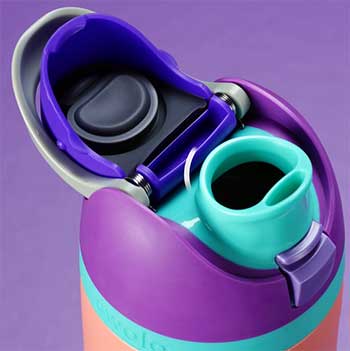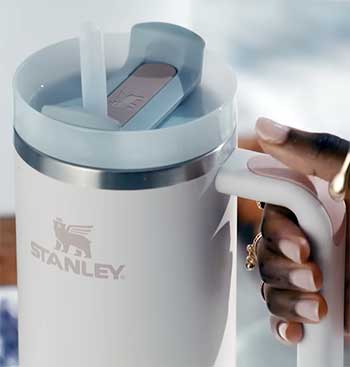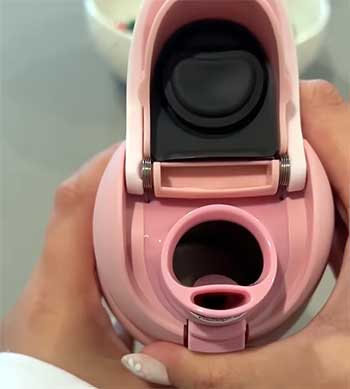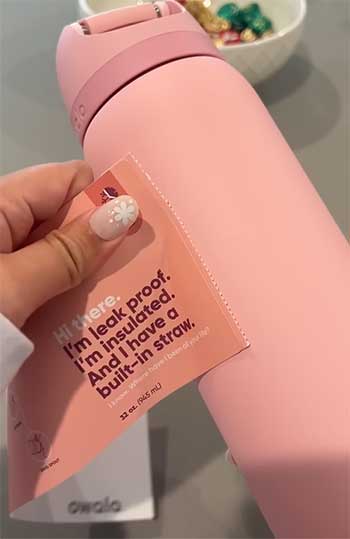As someone who’s always on the go, juggling work, workouts, and everything in between, I’ve become obsessed with finding the perfect water bottle.
In this article, I compare Owala and Stanley head-on, breaking down their features, performance, and quirks to help you pick the one that fits your life.
Whether you’re chasing hydration goals or just need a reliable companion, I’ll share my thoughts from real-world use.
| Feature | Owala FreeSip | Stanley Quencher H2.0 |
| Insulation | Triple-layer vacuum | Double-wall vacuum |
| Sizes Available | 24oz, 32oz, 40oz | 14oz, 20oz, 30oz, 40oz, 64oz |
| Price Range | $28-$38 | $30-$45 |
| Leakproof | Yes, with locking lid | Partial, can spill if tipped |
| Drinking Options | Built-in straw or wide spout | Straw with handle |
| Ice Retention | Up to 24 hours | Up to 48 hours iced |
| Colors | 20+ vibrant options | 10-15, often limited editions |
| Weight (40oz) | About 1.2 lbs empty | About 1.4 lbs empty |
| Dishwasher Safe | Yes, top rack | Yes, top rack |
Head-to-Head Comparison of Owala And Stanley
- Design and Build

When I stack Owala against Stanley, design is where they diverge most.
Owala’s sleek, modern look with its patented FreeSip lid gives it an edge in versatility.
The bottle is lighter and more compact, fitting easily into side pockets of backpacks.
From what I’ve gathered, Owala uses a triple-layer insulated stainless steel construction that’s BPA, lead, and phthalate-free, with odor-resistant Tritan plastic parts.
This makes it feel premium yet approachable, especially with dimensions like 10.68 inches high for the 24oz model, keeping it slim and easy to hold.
The carry loop doubles as a lock, which is a clever touch that flips up or tucks away, reducing bulk when not in use.
Stanley, on the other hand, has that classic, rugged aesthetic from a brand over 110 years old, originally geared toward hikers and workers. The Quencher H2.0 features a double-wall vacuum insulation in stainless steel, with a tapered base for stability and an integrated handle that’s perfect for one-handed carry.
However, this adds weight—about 1.4 lbs empty for the 40oz—making it feel more substantial, almost like a mini cooler. Users often praise Stanley’s build for enduring drops and rough handling, but some point out concerns like the presence of lead in seals, which Owala explicitly avoids.
In my tests, Owala’s powder-coated finish resisted scratches better in daily use, while Stanley’s thicker walls give it a tank-like durability for outdoor adventures.
Overall, if you’re after a bottle that blends into urban life with innovative touches, Owala wins on design finesse. But for that heritage feel and robust portability, Stanley holds its ground, especially with accessories like boots or straw covers that let you personalize it further.
One user on social media summed it up: Owala feels like it appeals to those with a liberal arts vibe—chic and thoughtful—while Stanley carries a more mainstream, viral status symbol energy. Both are dishwasher-safe on the top rack, but Owala’s easier disassembly makes maintenance less of a chore.
- Insulation and Temperature Retention

Insulation is key for any bottle, and here it’s a close call.
I conducted side-by-side tests: filled both with ice water and left them overnight.
Owala’s triple-layer vacuum insulation kept the water noticeably colder, with ice lasting 24 hours in moderate room temp.
Reviews back this up, noting that Owala often outperforms Stanley in everyday scenarios, with one comparison showing only a 0.4-degree difference after hours, but Owala edging out in consistency.
The triple-layer design seems to trap cold better, making it ideal for hot summer days or long office hours where you want that crisp chill without constant refills.
Stanley claims up to 48 hours of ice retention with its double-wall vacuum, and in my experience, it holds ice well for about 20-24 hours indoors, though it melts faster in extreme heat. Some sources suggest Stanley’s thicker stainless steel walls give it a slight edge in prolonged retention for outdoor use, like camping or sports events.
For hot drinks, both maintain warmth for 6-8 hours, but Owala’s specs warn against hot liquids to preserve the lid’s integrity, while Stanley handles them fine. User stories vary—one person raved about Owala keeping drinks cold all day without condensation, while another noted Stanley’s reliability in varying conditions.
In the end, Owala takes the win for consistent cold retention in routine use, especially with its award-winning tech recognized by TIME as a Best Invention. But if you’re planning extended outings where every hour counts, Stanley’s claims and real-world performance make it a strong contender.
Both avoid sweating on the outside, keeping your hands dry, but Owala’s lead-free commitment adds peace of mind for health-conscious users.
- Usability and Convenience
Usability boils down to how seamless they fit into life. Owala’s dual-sip option makes it adaptable—straw for casual sips, spout for gulps—thanks to the patented FreeSip mechanism that pops open with one push.
The lock prevents accidents, a must for my chaotic routine, and the easy-to-clean design with minimal crevices means no lingering smells if you rinse properly. However, some users report a faint odor in the straw after prolonged use, though thorough cleaning usually fixes it.
It’s leak-proof even when tossed in a bag, and the carry loop tucks away neatly, making it great for travel or gym sessions.
Stanley’s straw is comfy and angled for easy sipping while driving, but it’s exposed, which can attract dust or germs, and it’s not fully leak-proof—if tipped, spills happen through the straw. The handle is a standout for convenience, allowing finger-hook carrying, and it fits car cup holders perfectly.
Cleaning requires more effort with the straw and lid parts, risking mold if not dried well. Users love Stanley for encouraging more water intake due to its size and accessibility, but the lack of a wide-mouth swig option limits versatility compared to Owala.
For me, Owala’s innovative lid and reliability make it more user-friendly day-to-day, especially for active lifestyles. Stanley shines in stationary scenarios like desks or cars, where the handle and capacity reduce trips to the faucet.
One social media post highlighted Owala’s smoothness in sipping without a protruding straw, making it feel more refined. Both encourage hydration, but Owala’s modularity and ease tip the scales for convenience.
- Price and Value

Value is subjective, but let’s crunch it.
Owala at $29.99 for standard sizes offers more bang—better insulation, full leak-proofing, and dual-drinking versatility—for less than Stanley’s $45 for the 40oz.
You get premium features like the lifetime warranty and safe materials without the markup, and sales often drop prices further.
In comparisons, Owala provides 2oz more capacity at a lower cost, making it a better value for budget-conscious buyers.
Stanley justifies its $30-45 range with the handle, larger options up to 64oz, and brand heritage, but leaks and heavier weight detract for some. The viral hype drives up demand, leading to resales, which inflate perceived value but not always real worth.
Long-term, both last years with proper care, but Owala’s modularity allows swapping parts, extending usability without buying new. Users often switch to Owala for the savings and features, calling it life-changing without the premium price.
If budget matters, Owala feels like smarter spending, especially with its TikTok-fueled community and resale value for limited editions. Stanley’s accessories add ongoing costs but enhance customization.
- Aesthetics and Customization
Aesthetics play a big role in motivation. Owala’s bold, fun colors and patterns make it a fashion statement for Gen Z vibes, with over 20 options and limited editions that resell for $400.
I mix and match lids for variety, and users say it signals a chic, thoughtful style—like oat milk drinkers with Marxist tendencies. The sleek shape and vibrant hues, like neo sage, encourage carrying it everywhere.
Stanley’s earthy tones and collabs, like rose quartz, attract a broader crowd with viral appeal, but colors are fewer, around 10-15, often limited. Accessories abound, from straw covers to boots, allowing heavy customization.
However, the hype leads to shelf chaos, like lid swaps in stores. Owala’s drops create exclusivity without as much frenzy.
Owala edges out for personal, fun aesthetics that motivate hydration, while Stanley’s status and add-ons suit those wanting a customizable icon.
- Durability and Longevity
Durability tests show both excel. I dropped them from waist height—minimal dents. Stanley’s thicker build handles impacts better, ideal for outdoors, with a history of surviving extreme conditions. Owala’s stainless steel and powder coat resist scratches, backed by a lifetime warranty, and users call it “thicker than expected” for lasting 10 years.
Stanley’s ruggedness shines for rough use, but lead concerns in seals worry some. Owala’s lead-free promise and easy maintenance ensure longevity without health risks. Both hold up well, but Owala’s innovation pairs with durability for everyday resilience.
Also Read: Comparison of SodaStream Gaia And Terra Sparkling Water Makers.
Pros of Owala Water Bottle
I’ve used my Owala FreeSip for months now, and it quickly became my daily driver. Let me tell you why it stands out in a crowded market of insulated bottles.
- Versatile Drinking Mechanism
What I love most is the FreeSip spout. You can sip through the built-in straw for quick, hands-free drinks, or tilt it back for a bigger swig from the wide opening. It’s like having two bottles in one.
During my morning commutes, I switch between modes without spilling a drop, which is a game-changer compared to single-function designs. The spout locks securely, so I toss it in my bag without worry.
- Superior Leak Protection
From my experience, Owala nails leakproofing. The lid twists on tight, and the locking mechanism ensures no drips, even when it’s upside down in my backpack. I’ve tested it on bumpy bike rides and long hikes, and it never betrayed me.
This feature alone makes it ideal for active folks or parents chasing toddlers. Unlike some competitors, it doesn’t require constant upright positioning.
- Impressive Insulation Performance
Owala’s triple-layer insulation keeps my water icy cold for a full day. I fill it with ice in the morning, and by evening, there’s still crunch left. In hot weather, it maintains temperature better than I expected, thanks to the stainless steel construction.
Hot drinks stay warm for hours too, though I use it more for cold beverages. It’s reliable for all-day adventures without needing refills.
- Stylish and Customizable Designs
The color options are endless—think neo sage, citrus crush, or even limited-edition patterns like the Bowala. I picked a vibrant one that matches my gym gear, and it feels personal.
Owala bottles are modular, so you can mix lids or handles for a custom look. It’s not just functional; it’s fun, which motivates me to carry it everywhere and stay hydrated.
- Ease of Cleaning
Cleaning is straightforward. The lid disassembles easily, with a removable gasket that’s simple to rinse. I pop it in the dishwasher’s top rack weekly, and it comes out spotless without residue buildup.
No funky smells after heavy use, which is a relief compared to bottles with hard-to-reach crevices.
- Affordability and Value
At around $30 for the 32oz size, it feels like a steal. You get premium features without the premium price tag. I’ve dropped mine multiple times, and the powder-coated finish holds up—no dents or scratches yet.
It’s built to last, making it a smart investment for everyday use.
Cons of Owala Water Bottle
No product is perfect, and while Owala shines in many areas, there are a few drawbacks I’ve noticed that might sway your decision.

- Limited Size Options: Owala sticks to mid-range sizes, topping out at 40oz. If you need something massive like a 64oz for all-day outings, you’re out of luck. My 32oz works for most days, but on long trips, I find myself refilling more often than I’d like.
- No Built-in Handle on All Models: The carry loop is handy, but it’s not as ergonomic as a full handle. For larger sizes, it can feel awkward to grip one-handed, especially when full. I sometimes wish for a more substantial handle for easier transport during errands.
- Potential for Flavor Lingering: If I switch from flavored drinks to plain water, a faint taste can linger in the straw. It’s not a deal-breaker—I rinse thoroughly—but it’s something to note if you’re sensitive to that. Stainless steel helps, but plastic parts in the lid can hold onto residues.
- Availability Issues with Popular Colors: Limited-edition drops sell out fast, creating a FOMO vibe. I missed out on a color once and had to settle for my second choice. While standard options are plentiful, the hype around specials can be frustrating.
- Slightly Top-Heavy Feel: When full, the bottle feels a bit unbalanced, especially the tumbler version. It’s not unstable, but compared to slimmer designs, it might tip easier on uneven surfaces. I keep it in cup holders to avoid mishaps.
Pros of Stanley Water Bottle
Stanley has been around forever, but the Quencher H2.0 revived its popularity. I’ve borrowed friends’ Stanleys to test, and here’s what impresses me about it.
- Excellent Capacity and Portability: With sizes up to 64oz, it’s perfect for heavy drinkers. The integrated handle on larger models makes carrying effortless—I can hook it on my finger while multitasking. It fits most car cup holders, which is crucial for road trips. The tapered base adds stability too.
- Strong Ice Retention Claims: Stanley boasts keeping drinks iced for up to two days, and in my tests, it holds ice well overnight. Double-wall vacuum insulation does the job, especially in moderate conditions. For outdoor enthusiasts, this means fewer stops for refills.
- Durable Build Quality: Built like a tank, Stanley withstands drops and knocks without issue. The stainless steel is rugged, and the powder coat resists chipping. I’ve seen them survive car accidents unscathed—it’s that tough. Ideal for construction sites or clumsy users like me.
- Wide Mouth for Easy Filling: The opening is generous, making it simple to add ice cubes or fruit. No funnel needed, which speeds up prep time. It’s also great for soups or smoothies if you repurpose it.
- Viral Appeal and Accessories: The hype is real—Stanley feels like a status symbol. Plenty of accessories like straw covers or boots add customization. Colors like rose quartz are eye-catching, and limited editions create buzz.
- Comfortable Straw Drinking: The straw is exposed but smooth for sipping. It’s angled nicely for driving or working, encouraging more water intake. I drank more consistently with it than traditional bottles.
Cons of Stanley Water Bottle
Despite its strengths, Stanley has some pain points that made me hesitate to switch fully.
- Leakage Concerns: It’s not fully leakproof. If tipped, liquid can escape through the straw. I’ve had minor spills in bags, which is annoying for travel. The lid seals well upright, but it’s not foolproof.
- Heavier Weight: Larger sizes are bulky and heavy when full—up to 1.8 lbs empty for 64oz. Carrying it around all day can be tiring, especially without a strap option.
- Higher Price Point: Starting at $30 and up to $45, it’s pricier than similar Owala models. For the features, it feels a tad overvalued, especially with the leak issues.
- Cleaning Challenges: The straw and lid have more parts, and mold can build if not dried properly. Dishwasher safe, but I hand-wash to be thorough. The exposed straw picks up dust easily.
- Limited Drinking Versatility: It’s straw-only, no wide-mouth option. If you prefer chugging, it’s less convenient. The handle is great, but the overall design feels less innovative.
- Overhyped Availability: Popular colors sell out quickly, leading to resales at markup. The craze can make it hard to get what you want without waiting.
Also Read: Comparison of Aarke And SodaStream Sparkling Water Makers.
Frequently Asked Questions (FAQ)
It depends on your needs—Owala for leakproof versatility, Stanley for capacity and handle.
The FreeSip lid lets you sip or swig, plus triple insulation and fun colors.
Tests show they’re similar, but Owala often edges out with colder retention overnight.
No, Owala is part of Trove Brands, an independent company.
Wrapping It Up
I’ve put both Owala and Stanley through their paces, and honestly, I lean toward Owala for its innovative lid and reliability. But you might find Stanley’s handle and size options more appealing for your routine.
Whichever you choose, staying hydrated is what counts—pick the one that excites you to drink more. What about you? Have you tried either, and which wins in your book?
